Abstract
Recent studies show that young children can be exposed to pesticides during normal oral exploration of their environment and their level of dermal contact with floors and other surfaces. Children living in agricultural areas may be exposed to higher pesticide levels than other children because of pesticides tracked into their homes by household members, by pesticide drift, by breast milk from their farmworker mother, or by playing in nearby fields. Nevertheless, few studies have assessed the extent of children's pesticide exposure, and no studies have examined whether there are adverse health effects of chronic exposure. There is substantial toxicologic evidence that repeated low-level exposure to organophosphate (OP) pesticides may affect neurodevelopment and growth in developing animals. For example, animal studies have reported neurobehavorial effects such as impairment on maze performance, locomotion, and balance in neonates exposed (italic)in utero(/italic) and during early postnatal life. Possible mechanisms for these effects include inhibition of brain acetylcholinesterase, downregulation of muscarinic receptors, decreased brain DNA synthesis, and reduced brain weight in offspring. Research findings also suggest that it is biologically plausible that OP exposure may be related to respiratory disease in children through dysregulation of the autonomic nervous system. The University of California Berkeley Center for Children's Environmental Health Research is working to build a community-university partnership to study the environmental health of rural children. This Center for the Health Assessment of Mothers and Children of Salinas, or CHAMACOS in Monterey County, California, will assess (italic)in utero(/italic) and postnatal OP pesticide exposure and the relationship of exposure to neurodevelopment, growth, and symptoms of respiratory illness in children. The ultimate goal of the center is to translate research findings into a reduction of children's exposure to pesticides and other environmental agents, and thereby reduce the incidence of environmentally related disease.
Full text
PDF
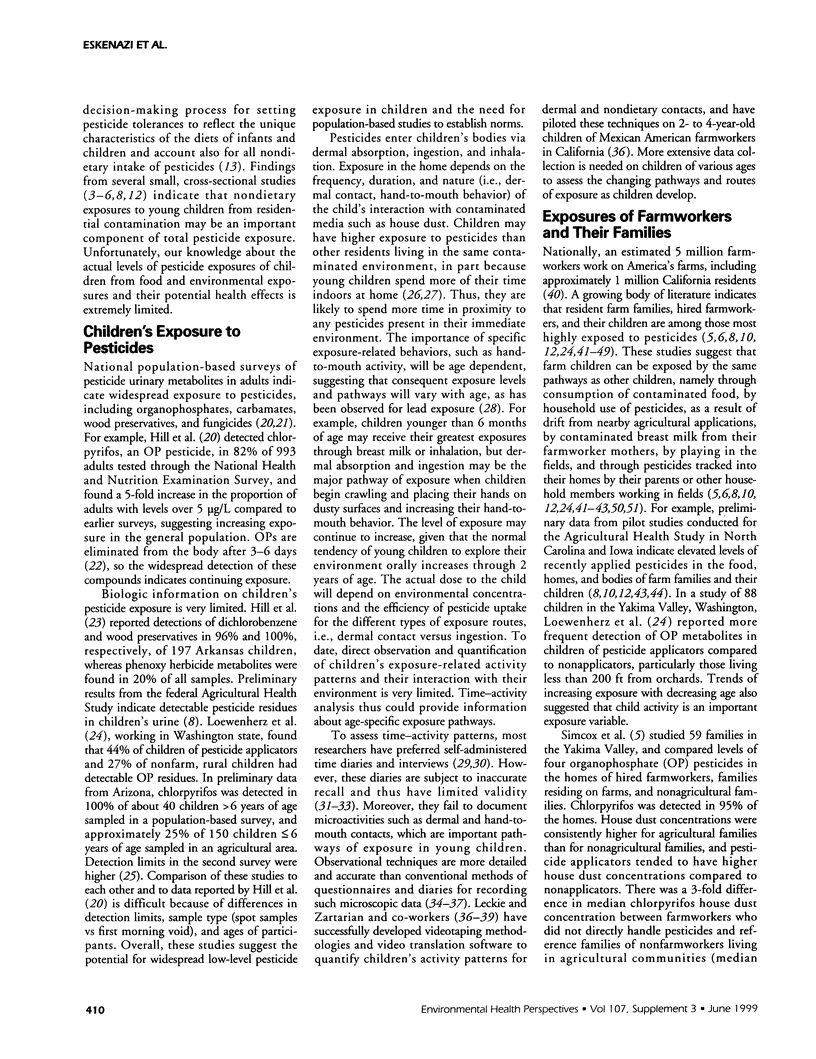
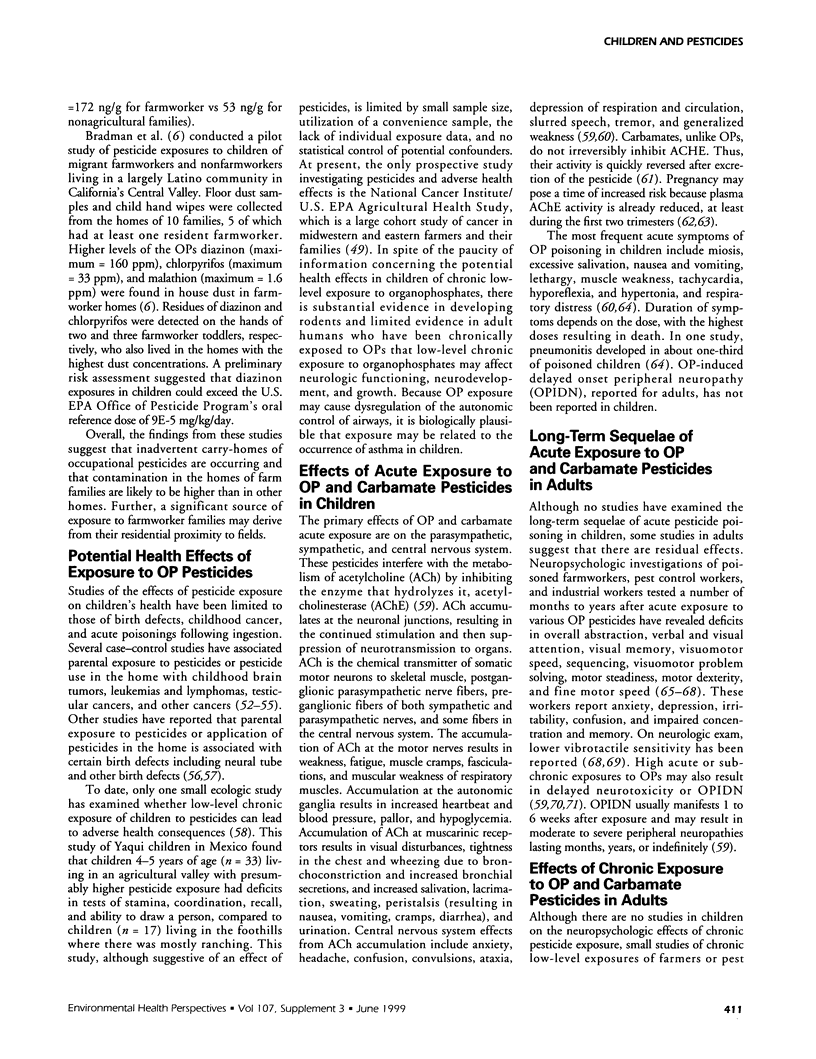
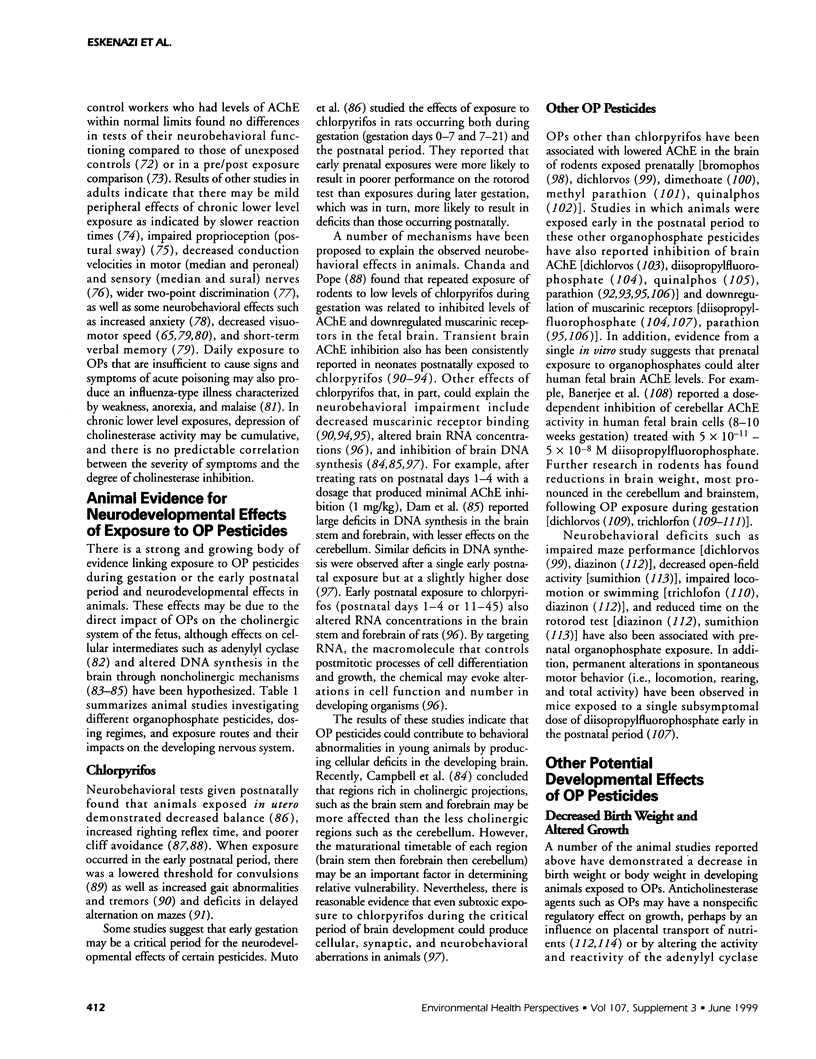
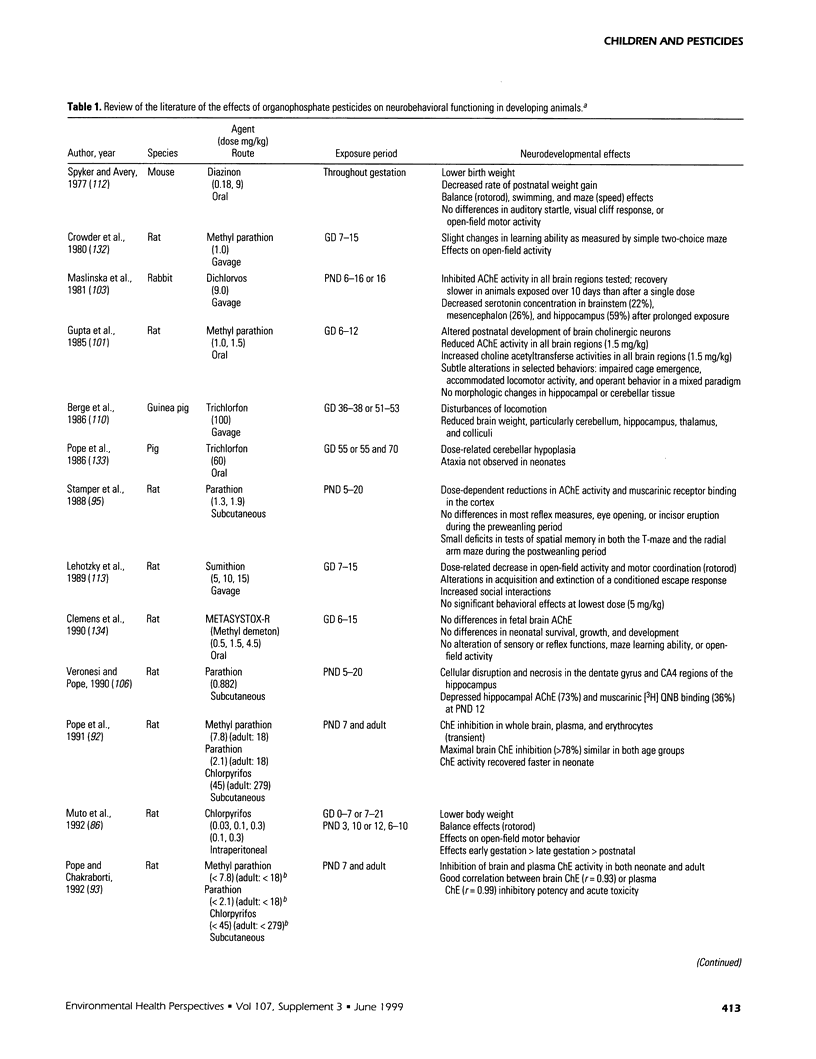
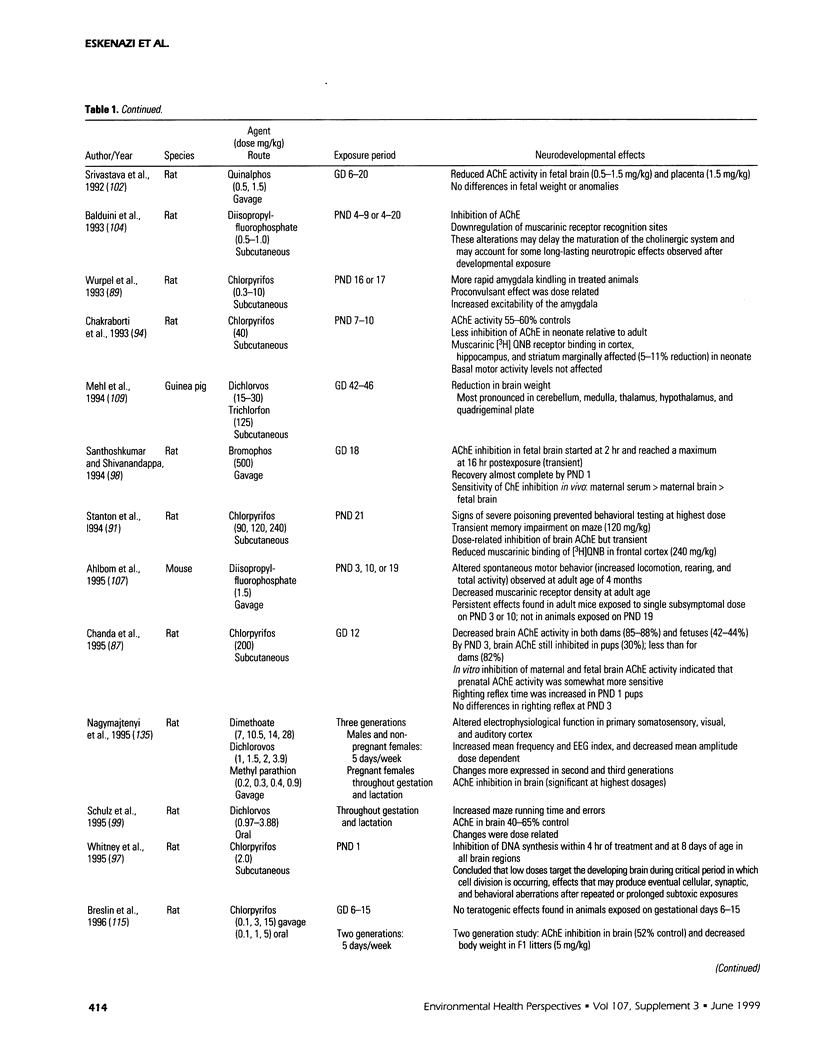
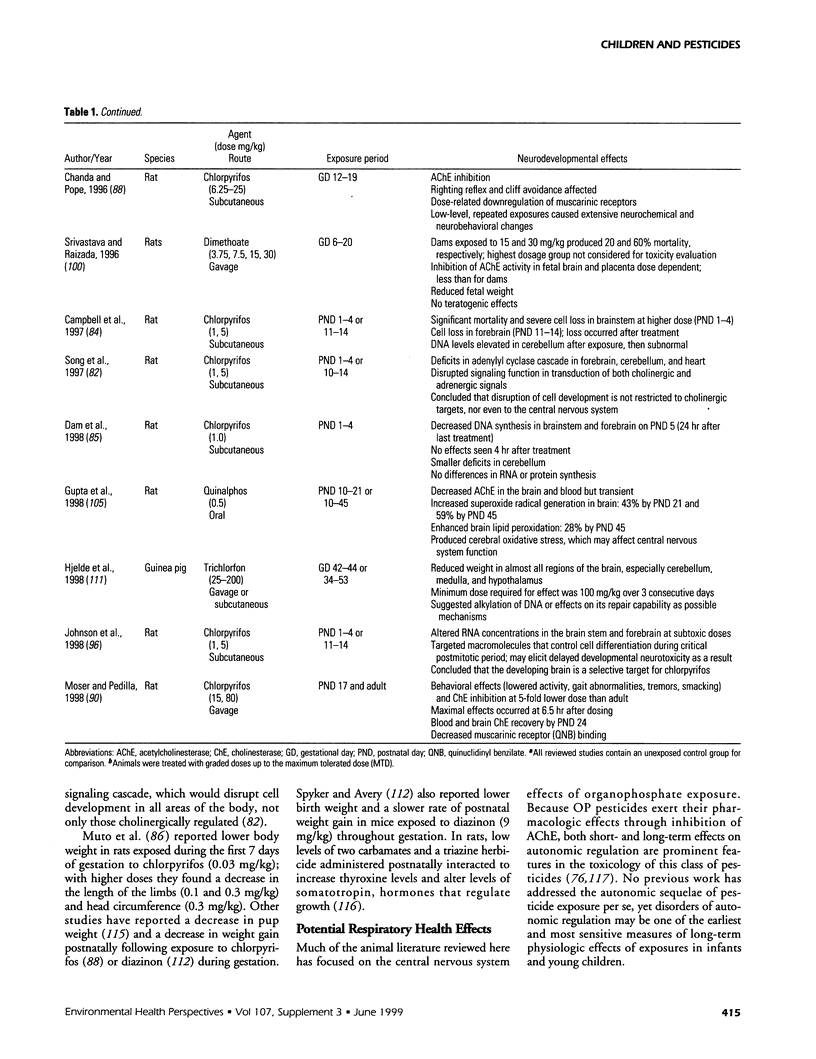
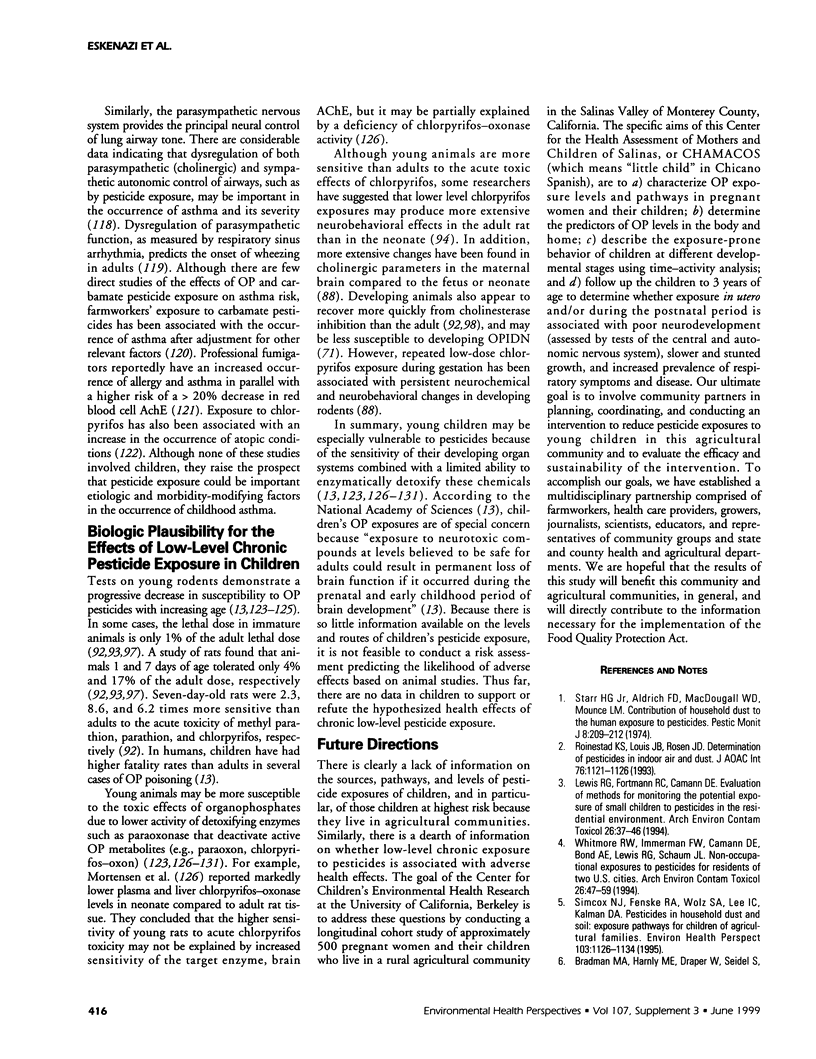

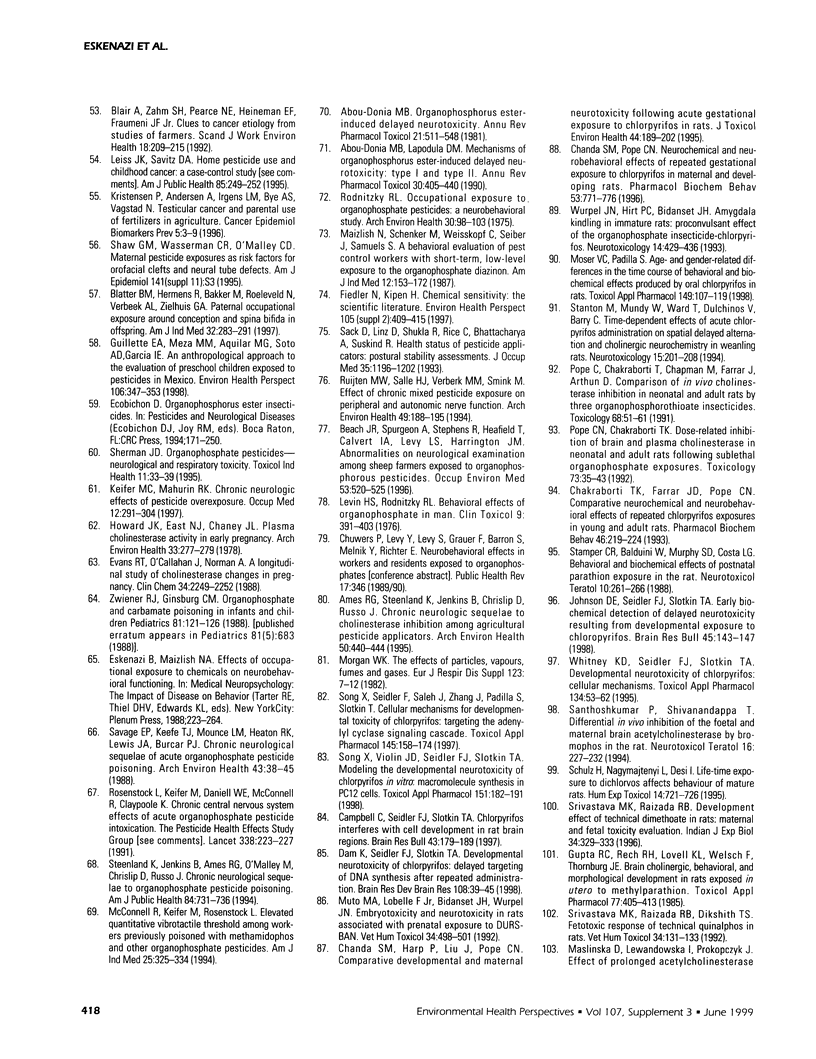
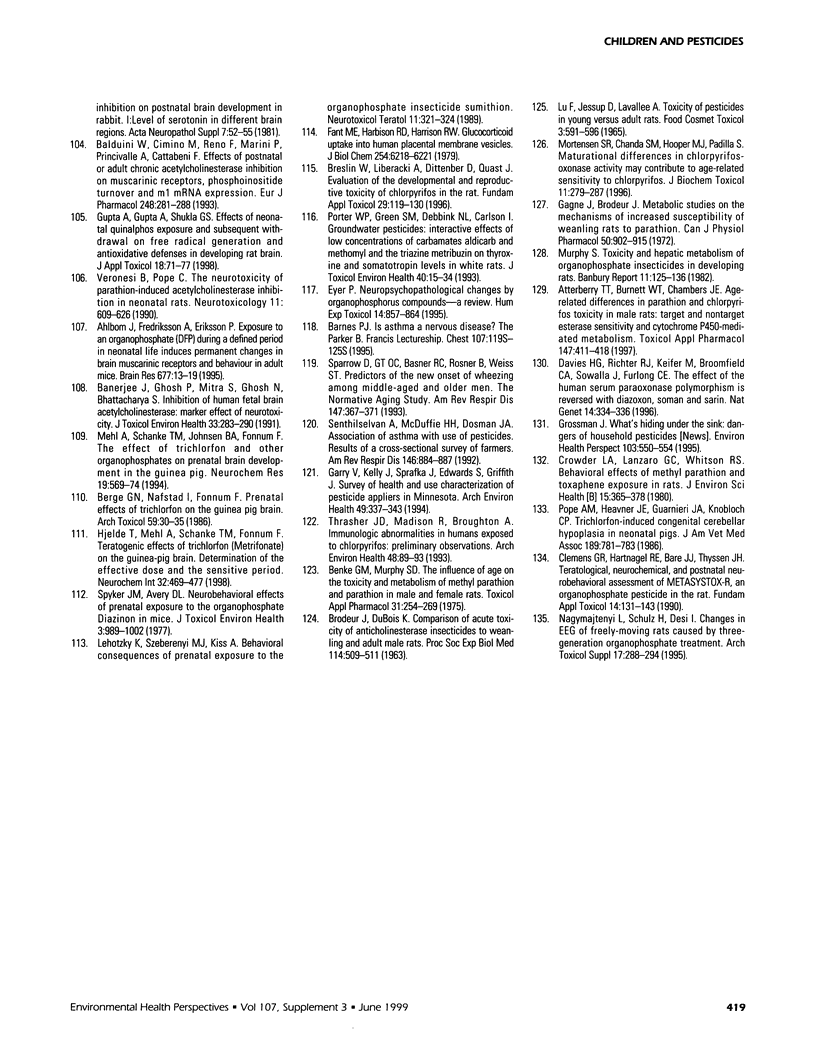
Selected References
These references are in PubMed. This may not be the complete list of references from this article.
- Abou-Donia M. B., Lapadula D. M. Mechanisms of organophosphorus ester-induced delayed neurotoxicity: type I and type II. Annu Rev Pharmacol Toxicol. 1990;30:405–440. doi: 10.1146/annurev.pa.30.040190.002201. [DOI] [PubMed] [Google Scholar]
- Abou-Donia M. B. Organophosphorus ester-induced delayed neurotoxicity. Annu Rev Pharmacol Toxicol. 1981;21:511–548. doi: 10.1146/annurev.pa.21.040181.002455. [DOI] [PubMed] [Google Scholar]
- Ahlbom J., Fredriksson A., Eriksson P. Exposure to an organophosphate (DFP) during a defined period in neonatal life induces permanent changes in brain muscarinic receptors and behaviour in adult mice. Brain Res. 1995 Apr 17;677(1):13–19. doi: 10.1016/0006-8993(95)00024-k. [DOI] [PubMed] [Google Scholar]
- Alavanja M. C., Sandler D. P., McMaster S. B., Zahm S. H., McDonnell C. J., Lynch C. F., Pennybacker M., Rothman N., Dosemeci M., Bond A. E. The Agricultural Health Study. Environ Health Perspect. 1996 Apr;104(4):362–369. doi: 10.1289/ehp.96104362. [DOI] [PMC free article] [PubMed] [Google Scholar]
- Ames R. G., Steenland K., Jenkins B., Chrislip D., Russo J. Chronic neurologic sequelae to cholinesterase inhibition among agricultural pesticide applicators. Arch Environ Health. 1995 Nov-Dec;50(6):440–444. doi: 10.1080/00039896.1995.9935980. [DOI] [PubMed] [Google Scholar]
- Atterberry T. T., Burnett W. T., Chambers J. E. Age-related differences in parathion and chlorpyrifos toxicity in male rats: target and nontarget esterase sensitivity and cytochrome P450-mediated metabolism. Toxicol Appl Pharmacol. 1997 Dec;147(2):411–418. doi: 10.1006/taap.1997.8303. [DOI] [PubMed] [Google Scholar]
- BRODEUR J., DUBOIS K. P. COMPARISON OF ACUTE TOXICITY OF ANTICHOLINESTERASE INSECTICIDES TO WEANLING AND ADULT MALE RATS. Proc Soc Exp Biol Med. 1963 Nov;114:509–511. doi: 10.3181/00379727-114-28716. [DOI] [PubMed] [Google Scholar]
- Balduini W., Cimino M., Renò F., Marini P., Princivalle A., Cattabeni F. Effects of postnatal or adult chronic acetylcholinesterase inhibition on muscarinic receptors, phosphoinositide turnover and m1 mRNA expression. Eur J Pharmacol. 1993 Dec 1;248(4):281–288. doi: 10.1016/0926-6917(93)90001-7. [DOI] [PubMed] [Google Scholar]
- Banerjee J., Ghosh P., Mitra S., Ghosh N., Bhattacharya S. Inhibition of human fetal brain acetylcholinesterase: marker effect of neurotoxicity. J Toxicol Environ Health. 1991 Jul;33(3):283–290. doi: 10.1080/15287399109531527. [DOI] [PubMed] [Google Scholar]
- Barnes P. J. Is asthma a nervous disease? The Parker B. Francis Lectureship. Chest. 1995 Mar;107(3 Suppl):119S–125S. doi: 10.1378/chest.107.3_supplement.119s. [DOI] [PubMed] [Google Scholar]
- Beach J. R., Spurgeon A., Stephens R., Heafield T., Calvert I. A., Levy L. S., Harrington J. M. Abnormalities on neurological examination among sheep farmers exposed to organophosphorous pesticides. Occup Environ Med. 1996 Aug;53(8):520–525. doi: 10.1136/oem.53.8.520. [DOI] [PMC free article] [PubMed] [Google Scholar]
- Benke G. M., Murphy S. D. The influence of age on the toxicity and metabolism of methyl parathion and parathion in male and female rats. Toxicol Appl Pharmacol. 1975 Feb;31(2):254–269. doi: 10.1016/0041-008x(75)90161-1. [DOI] [PubMed] [Google Scholar]
- Berge G. N., Nafstad I., Fonnum F. Prenatal effects of trichlorfon on the guinea pig brain. Arch Toxicol. 1986 May;59(1):30–35. doi: 10.1007/BF00263954. [DOI] [PubMed] [Google Scholar]
- Blair A., Zahm S. H., Pearce N. E., Heineman E. F., Fraumeni J. F., Jr Clues to cancer etiology from studies of farmers. Scand J Work Environ Health. 1992 Aug;18(4):209–215. doi: 10.5271/sjweh.1578. [DOI] [PubMed] [Google Scholar]
- Blatter B. M., Hermens R., Bakker M., Roeleveld N., Verbeek A. L., Zielhuis G. A. Paternal occupational exposure around conception and spina bifida in offspring. Am J Ind Med. 1997 Sep;32(3):283–291. doi: 10.1002/(sici)1097-0274(199709)32:3<283::aid-ajim15>3.0.co;2-r. [DOI] [PubMed] [Google Scholar]
- Bradman M. A., Harnly M. E., Draper W., Seidel S., Teran S., Wakeham D., Neutra R. Pesticide exposures to children from California's Central Valley: results of a pilot study. J Expo Anal Environ Epidemiol. 1997 Apr-Jun;7(2):217–234. [PubMed] [Google Scholar]
- Bradway D. E., Shafik T. M., Lores E. M. Comparison of cholinesterase activity, residue levels, and urinary metabolite excretion of rats exposed to organophosphorus pesticides. J Agric Food Chem. 1977 Nov-Dec;25(6):1353–1358. doi: 10.1021/jf60214a007. [DOI] [PubMed] [Google Scholar]
- Breslin W. J., Liberacki A. B., Dittenber D. A., Quast J. F. Evaluation of the developmental and reproductive toxicity of chlorpyrifos in the rat. Fundam Appl Toxicol. 1996 Jan;29(1):119–130. doi: 10.1006/faat.1996.0013. [DOI] [PubMed] [Google Scholar]
- Brown L. M., Blair A., Gibson R., Everett G. D., Cantor K. P., Schuman L. M., Burmeister L. F., Van Lier S. F., Dick F. Pesticide exposures and other agricultural risk factors for leukemia among men in Iowa and Minnesota. Cancer Res. 1990 Oct 15;50(20):6585–6591. [PubMed] [Google Scholar]
- Buckley J. D., Robison L. L., Swotinsky R., Garabrant D. H., LeBeau M., Manchester P., Nesbit M. E., Odom L., Peters J. M., Woods W. G. Occupational exposures of parents of children with acute nonlymphocytic leukemia: a report from the Childrens Cancer Study Group. Cancer Res. 1989 Jul 15;49(14):4030–4037. [PubMed] [Google Scholar]
- Campbell C. G., Seidler F. J., Slotkin T. A. Chlorpyrifos interferes with cell development in rat brain regions. Brain Res Bull. 1997;43(2):179–189. doi: 10.1016/s0361-9230(96)00436-4. [DOI] [PubMed] [Google Scholar]
- Chakraborti T. K., Farrar J. D., Pope C. N. Comparative neurochemical and neurobehavioral effects of repeated chlorpyrifos exposures in young and adult rats. Pharmacol Biochem Behav. 1993 Sep;46(1):219–224. doi: 10.1016/0091-3057(93)90344-s. [DOI] [PubMed] [Google Scholar]
- Chanda S. M., Harp P., Liu J., Pope C. N. Comparative developmental and maternal neurotoxicity following acute gestational exposure to chlorpyrifos in rats. J Toxicol Environ Health. 1995 Feb;44(2):189–202. doi: 10.1080/15287399509531954. [DOI] [PubMed] [Google Scholar]
- Chanda S. M., Pope C. N. Neurochemical and neurobehavioral effects of repeated gestational exposure to chlorpyrifos in maternal and developing rats. Pharmacol Biochem Behav. 1996 Apr;53(4):771–776. doi: 10.1016/0091-3057(95)02105-1. [DOI] [PubMed] [Google Scholar]
- Clark C. S., Bornschein R. L., Succop P., Que Hee S. S., Hammond P. B., Peace B. Condition and type of housing as an indicator of potential environmental lead exposure and pediatric blood lead levels. Environ Res. 1985 Oct;38(1):46–53. doi: 10.1016/0013-9351(85)90071-4. [DOI] [PubMed] [Google Scholar]
- Clemens G. R., Hartnagel R. E., Bare J. J., Thyssen J. H. Teratological, neurochemical, and postnatal neurobehavioral assessment of METASYSTOX-R, an organophosphate pesticide in the rat. Fundam Appl Toxicol. 1990 Jan;14(1):131–143. doi: 10.1016/0272-0590(90)90239-g. [DOI] [PubMed] [Google Scholar]
- Colt J. S. Comparison of pesticides and other compounds in carpet dust samples collected from used vacuum cleaner bags and from a high-volume surface sampler. Environ Health Perspect. 1998 Nov;106(11):721–724. doi: 10.1289/ehp.98106721. [DOI] [PMC free article] [PubMed] [Google Scholar]
- Crowder L. A., Lanzaro G. C., Whitson R. S. Behavioral effects of methyl parathion and toxaphene exposure in rats. J Environ Sci Health B. 1980;15(4):365–378. doi: 10.1080/03601238009372189. [DOI] [PubMed] [Google Scholar]
- Dam K., Seidler F. J., Slotkin T. A. Developmental neurotoxicity of chlorpyrifos: delayed targeting of DNA synthesis after repeated administration. Brain Res Dev Brain Res. 1998 Jun 15;108(1-2):39–45. doi: 10.1016/s0165-3806(98)00028-5. [DOI] [PubMed] [Google Scholar]
- Davies H. G., Richter R. J., Keifer M., Broomfield C. A., Sowalla J., Furlong C. E. The effect of the human serum paraoxonase polymorphism is reversed with diazoxon, soman and sarin. Nat Genet. 1996 Nov;14(3):334–336. doi: 10.1038/ng1196-334. [DOI] [PubMed] [Google Scholar]
- Evans R. T., O'Callaghan J., Norman A. A longitudinal study of cholinesterase changes in pregnancy. Clin Chem. 1988 Nov;34(11):2249–2252. [PubMed] [Google Scholar]
- Eyer P. Neuropsychopathological changes by organophosphorus compounds--a review. Hum Exp Toxicol. 1995 Nov;14(11):857–864. doi: 10.1177/096032719501401101. [DOI] [PubMed] [Google Scholar]
- Fant M. E., Harbison R. D., Harrison R. W. Glucocorticoid uptake into human placental membrane vesicles. J Biol Chem. 1979 Jul 25;254(14):6218–6221. [PubMed] [Google Scholar]
- Fiedler N., Kipen H. Chemical sensitivity: the scientific literature. Environ Health Perspect. 1997 Mar;105 (Suppl 2):409–415. doi: 10.1289/ehp.97105s2409. [DOI] [PMC free article] [PubMed] [Google Scholar]
- Gagné J., Brodeur J. Metabolic studies on the mechanisms of increased susceptibility of weaning rats to parathion. Can J Physiol Pharmacol. 1972 Sep;50(9):902–915. doi: 10.1139/y72-129. [DOI] [PubMed] [Google Scholar]
- Garry V. F., Kelly J. T., Sprafka J. M., Edwards S., Griffith J. Survey of health and use characterization of pesticide appliers in Minnesota. Arch Environ Health. 1994 Sep-Oct;49(5):337–343. doi: 10.1080/00039896.1994.9954984. [DOI] [PubMed] [Google Scholar]
- Grossman J. What's hiding under the sink: dangers of household pesticides. Environ Health Perspect. 1995 Jun;103(6):550–554. doi: 10.1289/ehp.95103550. [DOI] [PMC free article] [PubMed] [Google Scholar]
- Guillette E. A., Meza M. M., Aquilar M. G., Soto A. D., Garcia I. E. An anthropological approach to the evaluation of preschool children exposed to pesticides in Mexico. Environ Health Perspect. 1998 Jun;106(6):347–353. doi: 10.1289/ehp.98106347. [DOI] [PMC free article] [PubMed] [Google Scholar]
- Gupta A., Gupta A., Shukla G. S. Effects of neonatal quinalphos exposure and subsequent withdrawal on free radical generation and antioxidative defenses in developing rat brain. J Appl Toxicol. 1998 Jan-Feb;18(1):71–77. doi: 10.1002/(sici)1099-1263(199801/02)18:1<71::aid-jat482>3.0.co;2-b. [DOI] [PubMed] [Google Scholar]
- Gupta R. C., Rech R. H., Lovell K. L., Welsch F., Thornburg J. E. Brain cholinergic, behavioral, and morphological development in rats exposed in utero to methylparathion. Toxicol Appl Pharmacol. 1985 Mar 15;77(3):405–413. doi: 10.1016/0041-008x(85)90180-2. [DOI] [PubMed] [Google Scholar]
- Hill R. H., Jr, To T., Holler J. S., Fast D. M., Smith S. J., Needham L. L., Binder S. Residues of chlorinated phenols and phenoxy acid herbicides in the urine of Arkansas children. Arch Environ Contam Toxicol. 1989 Jul-Aug;18(4):469–474. doi: 10.1007/BF01055011. [DOI] [PubMed] [Google Scholar]
- Hjelde T., Mehl A., Schanke T. M., Fonnum F. Teratogenic effects of trichlorfon (Metrifonate) on the guinea-pig brain. Determination of the effective dose and the sensitive period. Neurochem Int. 1998 May-Jun;32(5-6):469–477. doi: 10.1016/s0197-0186(97)00125-3. [DOI] [PubMed] [Google Scholar]
- Howard J. K., East N. J., Chaney J. L. Plasma cholinesterase activity in early pregnancy. Arch Environ Health. 1978 Sep-Oct;33(5):277–279. doi: 10.1080/00039896.1978.10667347. [DOI] [PubMed] [Google Scholar]
- Johnson D. E., Seidler F. J., Slotkin T. A. Early biochemical detection of delayed neurotoxicity resulting from developmental exposure to chloropyrifos. Brain Res Bull. 1998;45(2):143–147. doi: 10.1016/s0361-9230(97)00329-8. [DOI] [PubMed] [Google Scholar]
- Keifer M. C., Mahurin R. K. Chronic neurologic effects of pesticide overexposure. Occup Med. 1997 Apr-Jun;12(2):291–304. [PubMed] [Google Scholar]
- Kristensen P., Andersen A., Irgens L. M., Bye A. S., Vagstad N. Testicular cancer and parental use of fertilizers in agriculture. Cancer Epidemiol Biomarkers Prev. 1996 Jan;5(1):3–9. [PubMed] [Google Scholar]
- Lehotzky K., Szeberenyi M. J., Kiss A. Behavioral consequences of prenatal exposure to the organophosphate insecticide sumithion. Neurotoxicol Teratol. 1989 May-Jun;11(3):321–324. doi: 10.1016/0892-0362(89)90076-7. [DOI] [PubMed] [Google Scholar]
- Leiss J. K., Savitz D. A. Home pesticide use and childhood cancer: a case-control study. Am J Public Health. 1995 Feb;85(2):249–252. doi: 10.2105/ajph.85.2.249. [DOI] [PMC free article] [PubMed] [Google Scholar]
- Levin H. S., Rodnitzky R. L. Behavioral effects of organophosphate in man. Clin Toxicol. 1976;9(3):391–403. doi: 10.3109/15563657608988138. [DOI] [PubMed] [Google Scholar]
- Lewis R. G., Fortmann R. C., Camann D. E. Evaluation of methods for monitoring the potential exposure of small children to pesticides in the residential environment. Arch Environ Contam Toxicol. 1994 Jan;26(1):37–46. doi: 10.1007/BF00212792. [DOI] [PubMed] [Google Scholar]
- Loewenherz C., Fenske R. A., Simcox N. J., Bellamy G., Kalman D. Biological monitoring of organophosphorus pesticide exposure among children of agricultural workers in central Washington State. Environ Health Perspect. 1997 Dec;105(12):1344–1353. doi: 10.1289/ehp.971051344. [DOI] [PMC free article] [PubMed] [Google Scholar]
- Lu F. C., Jessup D. C., Lavallée A. Toxicity of pesticides in young versus adult rats. Food Cosmet Toxicol. 1965 Oct;3(4):591–596. doi: 10.1016/s0015-6264(65)80206-1. [DOI] [PubMed] [Google Scholar]
- Maizlish N., Schenker M., Weisskopf C., Seiber J., Samuels S. A behavioral evaluation of pest control workers with short-term, low-level exposure to the organophosphate diazinon. Am J Ind Med. 1987;12(2):153–172. doi: 10.1002/ajim.4700120205. [DOI] [PubMed] [Google Scholar]
- Maślińska D., Lewandowska I., Prokopczyk J. Effect of prolonged acetylcholinesterase inhibition on postnatal brain development in rabbit. I. Level of serotonin in different brain regions. Acta Neuropathol Suppl. 1981;7:52–55. doi: 10.1007/978-3-642-81553-9_16. [DOI] [PubMed] [Google Scholar]
- McConnell R., Keifer M., Rosenstock L. Elevated quantitative vibrotactile threshold among workers previously poisoned with methamidophos and other organophosphate pesticides. Am J Ind Med. 1994 Mar;25(3):325–334. doi: 10.1002/ajim.4700250303. [DOI] [PubMed] [Google Scholar]
- Mehl A., Schanke T. M., Johnsen B. A., Fonnum F. The effect of trichlorfon and other organophosphates on prenatal brain development in the guinea pig. Neurochem Res. 1994 May;19(5):569–574. doi: 10.1007/BF00971332. [DOI] [PubMed] [Google Scholar]
- Melnyk L. J., Berry M. R., Sheldon L. S. Dietary exposure from pesticide application on farms in the Agricultural Health Pilot Study. J Expo Anal Environ Epidemiol. 1997 Jan-Mar;7(1):61–80. [PubMed] [Google Scholar]
- Mobed K., Gold E. B., Schenker M. B. Occupational health problems among migrant and seasonal farm workers. West J Med. 1992 Sep;157(3):367–373. [PMC free article] [PubMed] [Google Scholar]
- Morgan W. K. The effects of particles, vapours, fumes and gases. Eur J Respir Dis Suppl. 1982;123:7–12. [PubMed] [Google Scholar]
- Mortensen S. R., Chanda S. M., Hooper M. J., Padilla S. Maturational differences in chlorpyrifos-oxonase activity may contribute to age-related sensitivity to chlorpyrifos. J Biochem Toxicol. 1996;11(6):279–287. doi: 10.1002/(SICI)1522-7146(1996)11:6<279::AID-JBT3>3.0.CO;2-H. [DOI] [PubMed] [Google Scholar]
- Moser V. C., Padilla S. Age- and gender-related differences in the time course of behavioral and biochemical effects produced by oral chlorpyrifos in rats. Toxicol Appl Pharmacol. 1998 Mar;149(1):107–119. doi: 10.1006/taap.1997.8354. [DOI] [PubMed] [Google Scholar]
- Moses M., Johnson E. S., Anger W. K., Burse V. W., Horstman S. W., Jackson R. J., Lewis R. G., Maddy K. T., McConnell R., Meggs W. J. Environmental equity and pesticide exposure. Toxicol Ind Health. 1993 Sep-Oct;9(5):913–959. doi: 10.1177/074823379300900512. [DOI] [PubMed] [Google Scholar]
- Murphy R. S., Kutz F. W., Strassman S. C. Selected pesticide residues or metabolites in blood and urine specimens from a general population survey. Environ Health Perspect. 1983 Feb;48:81–86. doi: 10.1289/ehp.834881. [DOI] [PMC free article] [PubMed] [Google Scholar]
- Musicco M., Sant M., Molinari S., Filippini G., Gatta G., Berrino F. A case-control study of brain gliomas and occupational exposure to chemical carcinogens: the risk to farmers. Am J Epidemiol. 1988 Oct;128(4):778–785. doi: 10.1093/oxfordjournals.aje.a115031. [DOI] [PubMed] [Google Scholar]
- Muto M. A., Lobelle F., Jr, Bidanset J. H., Wurpel J. N. Embryotoxicity and neurotoxicity in rats associated with prenatal exposure to DURSBAN. Vet Hum Toxicol. 1992 Dec;34(6):498–501. [PubMed] [Google Scholar]
- Nagymajtényi L., Schulz H., Dési I. Changes in EEG of freely-moving rats caused by three-generation organophosphate treatment. Arch Toxicol Suppl. 1995;17:288–294. doi: 10.1007/978-3-642-79451-3_23. [DOI] [PubMed] [Google Scholar]
- Ott M. G., Teta M. J., Greenberg H. L. Assessment of exposure to chemicals in a complex work environment. Am J Ind Med. 1989;16(6):617–630. doi: 10.1002/ajim.4700160602. [DOI] [PubMed] [Google Scholar]
- Ott W. R. Exposure estimates based on computer generated activity patterns. J Toxicol Clin Toxicol. 1983;21(1-2):97–128. doi: 10.3109/15563658308990412. [DOI] [PubMed] [Google Scholar]
- Pope A. M., Heavner J. E., Guarnieri J. A., Knobloch C. P. Trichlorfon-induced congenital cerebellar hypoplasia in neonatal pigs. J Am Vet Med Assoc. 1986 Oct 1;189(7):781–783. [PubMed] [Google Scholar]
- Pope C. N., Chakraborti T. K., Chapman M. L., Farrar J. D., Arthun D. Comparison of in vivo cholinesterase inhibition in neonatal and adult rats by three organophosphorothioate insecticides. Toxicology. 1991;68(1):51–61. doi: 10.1016/0300-483x(91)90061-5. [DOI] [PubMed] [Google Scholar]
- Pope C. N., Chakraborti T. K. Dose-related inhibition of brain and plasma cholinesterase in neonatal and adult rats following sublethal organophosphate exposures. Toxicology. 1992;73(1):35–43. doi: 10.1016/0300-483x(92)90168-e. [DOI] [PubMed] [Google Scholar]
- Porter W. P., Green S. M., Debbink N. L., Carlson I. Groundwater pesticides: interactive effects of low concentrations of carbamates aldicarb and methomyl and the triazine metribuzin on thyroxine and somatotropin levels in white rats. J Toxicol Environ Health. 1993 Sep;40(1):15–34. doi: 10.1080/15287399309531773. [DOI] [PubMed] [Google Scholar]
- Richter E. D., Chuwers P., Levy Y., Gordon M., Grauer F., Marzouk J., Levy S., Barron S., Gruener N. Health effects from exposure to organophosphate pesticides in workers and residents in Israel. Isr J Med Sci. 1992 Aug-Sep;28(8-9):584–598. [PubMed] [Google Scholar]
- Rodnitzky R. L. Occupational exposure to organophosphate pesticides: a neurobehavioral study. Arch Environ Health. 1975 Feb;30(2):98–103. doi: 10.1080/00039896.1975.10666651. [DOI] [PubMed] [Google Scholar]
- Roinestad K. S., Louis J. B., Rosen J. D. Determination of pesticides in indoor air and dust. J AOAC Int. 1993 Sep-Oct;76(5):1121–1126. [PubMed] [Google Scholar]
- Rosenstock L., Keifer M., Daniell W. E., McConnell R., Claypoole K. Chronic central nervous system effects of acute organophosphate pesticide intoxication. The Pesticide Health Effects Study Group. Lancet. 1991 Jul 27;338(8761):223–227. doi: 10.1016/0140-6736(91)90356-t. [DOI] [PubMed] [Google Scholar]
- Ruijten M. W., Sallé H. J., Verberk M. M., Smink M. Effect of chronic mixed pesticide exposure on peripheral and autonomic nerve function. Arch Environ Health. 1994 May-Jun;49(3):188–195. doi: 10.1080/00039896.1994.9940381. [DOI] [PubMed] [Google Scholar]
- Sack D., Linz D., Shukla R., Rice C., Bhattacharya A., Suskind R. Health status of pesticide applicators: postural stability assessments. J Occup Med. 1993 Dec;35(12):1196–1202. [PubMed] [Google Scholar]
- Santhoshkumar P., Shivanandappa T. Differential in vivo inhibition of the foetal and maternal brain acetylcholinesterase by bromophos in the rat. Neurotoxicol Teratol. 1994 May-Jun;16(3):227–232. doi: 10.1016/0892-0362(94)90043-4. [DOI] [PubMed] [Google Scholar]
- Savage E. P., Keefe T. J., Mounce L. M., Heaton R. K., Lewis J. A., Burcar P. J. Chronic neurological sequelae of acute organophosphate pesticide poisoning. Arch Environ Health. 1988 Jan-Feb;43(1):38–45. doi: 10.1080/00039896.1988.9934372. [DOI] [PubMed] [Google Scholar]
- Schulz H., Nagymajtényi L., Dési I. Life-time exposure to dichlorvos affects behaviour of mature rats. Hum Exp Toxicol. 1995 Sep;14(9):721–726. doi: 10.1177/096032719501400904. [DOI] [PubMed] [Google Scholar]
- Senthilselvan A., McDuffie H. H., Dosman J. A. Association of asthma with use of pesticides. Results of a cross-sectional survey of farmers. Am Rev Respir Dis. 1992 Oct;146(4):884–887. doi: 10.1164/ajrccm/146.4.884. [DOI] [PubMed] [Google Scholar]
- Shealy D. B., Barr J. R., Ashley D. L., Patterson D. G., Jr, Camann D. E., Bond A. E. Correlation of environmental carbaryl measurements with serum and urinary 1-naphthol measurements in a farmer applicator and his family. Environ Health Perspect. 1997 May;105(5):510–513. doi: 10.1289/ehp.97105510. [DOI] [PMC free article] [PubMed] [Google Scholar]
- Sherman J. D. Organophosphate pesticides--neurological and respiratory toxicity. Toxicol Ind Health. 1995 Jan-Feb;11(1):33–39. doi: 10.1177/074823379501100103. [DOI] [PubMed] [Google Scholar]
- Silvers A., Florence B. T., Rourke D. L., Lorimor R. J. How children spend their time: a sample survey for use in exposure and risk assessments. Risk Anal. 1994 Dec;14(6):931–944. doi: 10.1111/j.1539-6924.1994.tb00062.x. [DOI] [PubMed] [Google Scholar]
- Simcox N. J., Fenske R. A., Wolz S. A., Lee I. C., Kalman D. A. Pesticides in household dust and soil: exposure pathways for children of agricultural families. Environ Health Perspect. 1995 Dec;103(12):1126–1134. doi: 10.1289/ehp.951031126. [DOI] [PMC free article] [PubMed] [Google Scholar]
- Sonawane B. R. Chemical contaminants in human milk: an overview. Environ Health Perspect. 1995 Sep;103 (Suppl 6):197–205. doi: 10.1289/ehp.95103s6197. [DOI] [PMC free article] [PubMed] [Google Scholar]
- Song X., Seidler F. J., Saleh J. L., Zhang J., Padilla S., Slotkin T. A. Cellular mechanisms for developmental toxicity of chlorpyrifos: targeting the adenylyl cyclase signaling cascade. Toxicol Appl Pharmacol. 1997 Jul;145(1):158–174. doi: 10.1006/taap.1997.8171. [DOI] [PubMed] [Google Scholar]
- Song X., Violin J. D., Seidler F. J., Slotkin T. A. Modeling the developmental neurotoxicity of chlorpyrifos in vitro: macromolecule synthesis in PC12 cells. Toxicol Appl Pharmacol. 1998 Jul;151(1):182–191. doi: 10.1006/taap.1998.8424. [DOI] [PubMed] [Google Scholar]
- Sparrow D., O'Connor G. T., Basner R. C., Rosner B., Weiss S. T. Predictors of the new onset of wheezing among middle-aged and older men. The Normative Aging Study. Am Rev Respir Dis. 1993 Feb;147(2):367–371. doi: 10.1164/ajrccm/147.2.367. [DOI] [PubMed] [Google Scholar]
- Spyker J. M., Avery D. L. Neurobehavioral effects of prenatal exposure to the organophosphate Diazinon in mice. J Toxicol Environ Health. 1977 Dec;3(5-6):989–1002. doi: 10.1080/15287397709529633. [DOI] [PubMed] [Google Scholar]
- Srivastava M. K., Raizada R. B. Development effect of technical dimethoate in rats: maternal and fetal toxicity evaluation. Indian J Exp Biol. 1996 Apr;34(4):329–333. [PubMed] [Google Scholar]
- Srivastava M. K., Raizada R. B., Dikshith T. S. Fetotoxic response of technical quinalphos in rats. Vet Hum Toxicol. 1992 Apr;34(2):131–133. [PubMed] [Google Scholar]
- Stamper C. R., Balduini W., Murphy S. D., Costa L. G. Behavioral and biochemical effects of postnatal parathion exposure in the rat. Neurotoxicol Teratol. 1988 May-Jun;10(3):261–266. doi: 10.1016/0892-0362(88)90026-8. [DOI] [PubMed] [Google Scholar]
- Stanton M. E., Mundy W. R., Ward T., Dulchinos V., Barry C. C. Time-dependent effects of acute chlorpyrifos administration on spatial delayed alternation and cholinergic neurochemistry in weanling rats. Neurotoxicology. 1994 Spring;15(1):201–208. [PubMed] [Google Scholar]
- Starr H. G., Jr, Aldrich F. D., MacDougall W. D., 3rd, Mounce L. M. Contribution of household dust to the human exposure to pesticides. Pestic Monit J. 1974 Dec;8(3):209–212. [PubMed] [Google Scholar]
- Steenland K., Jenkins B., Ames R. G., O'Malley M., Chrislip D., Russo J. Chronic neurological sequelae to organophosphate pesticide poisoning. Am J Public Health. 1994 May;84(5):731–736. doi: 10.2105/ajph.84.5.731. [DOI] [PMC free article] [PubMed] [Google Scholar]
- Thrasher J. D., Madison R., Broughton A. Immunologic abnormalities in humans exposed to chlorpyrifos: preliminary observations. Arch Environ Health. 1993 Mar-Apr;48(2):89–93. doi: 10.1080/00039896.1993.9938400. [DOI] [PubMed] [Google Scholar]
- Veronesi B., Pope C. The neurotoxicity of parathion-induced acetylcholinesterase inhibition in neonatal rats. Neurotoxicology. 1990 Winter;11(4):609–626. [PubMed] [Google Scholar]
- Whitemore R. W., Immerman F. W., Camann D. E., Bond A. E., Lewis R. G., Schaum J. L. Non-occupational exposures to pesticides for residents of two U.S. cities. Arch Environ Contam Toxicol. 1994 Jan;26(1):47–59. doi: 10.1007/BF00212793. [DOI] [PubMed] [Google Scholar]
- Whitney K. D., Seidler F. J., Slotkin T. A. Developmental neurotoxicity of chlorpyrifos: cellular mechanisms. Toxicol Appl Pharmacol. 1995 Sep;134(1):53–62. doi: 10.1006/taap.1995.1168. [DOI] [PubMed] [Google Scholar]
- Wurpel J. N., Hirt P. C., Bidanset J. H. Amygdala kindling in immature rats: proconvulsant effect of the organophosphate insecticide-chlorpyrifos. Neurotoxicology. 1993 Winter;14(4):429–436. [PubMed] [Google Scholar]
- Zartarian V. G., Ferguson A. C., Leckie J. O. Quantified dermal activity data from a four-child pilot field study. J Expo Anal Environ Epidemiol. 1997 Oct-Dec;7(4):543–552. [PubMed] [Google Scholar]
- Zartarian V. G., Ferguson A. C., Ong C. G., Leckie J. O. Quantifying videotaped activity patterns: video translation software and training methodologies. J Expo Anal Environ Epidemiol. 1997 Oct-Dec;7(4):535–542. [PubMed] [Google Scholar]
- Zartarian V. G., Streicker J., Rivera A., Cornejo C. S., Molina S., Valadez O. F., Leckie J. O. A pilot study to collect micro-activity data of two- to four-year-old farm labor children in Salinas Valley, California. J Expo Anal Environ Epidemiol. 1995 Jan-Mar;5(1):21–34. [PubMed] [Google Scholar]
- Zwiener R. J., Ginsburg C. M. Organophosphate and carbamate poisoning in infants and children. Pediatrics. 1988 Jan;81(1):121–126. [PubMed] [Google Scholar]


